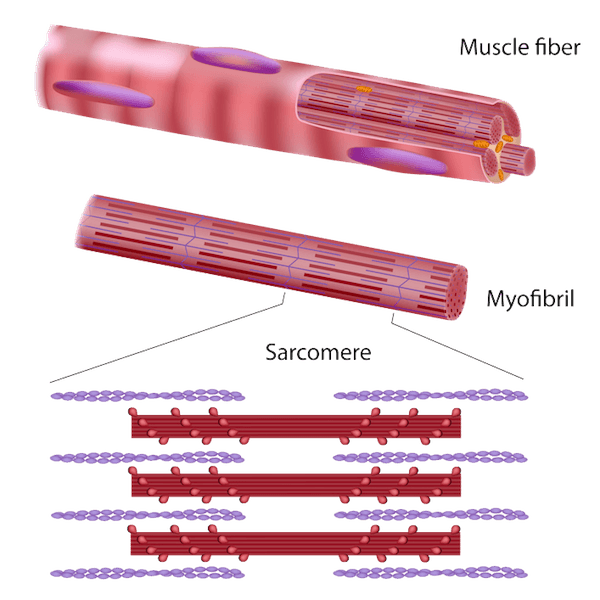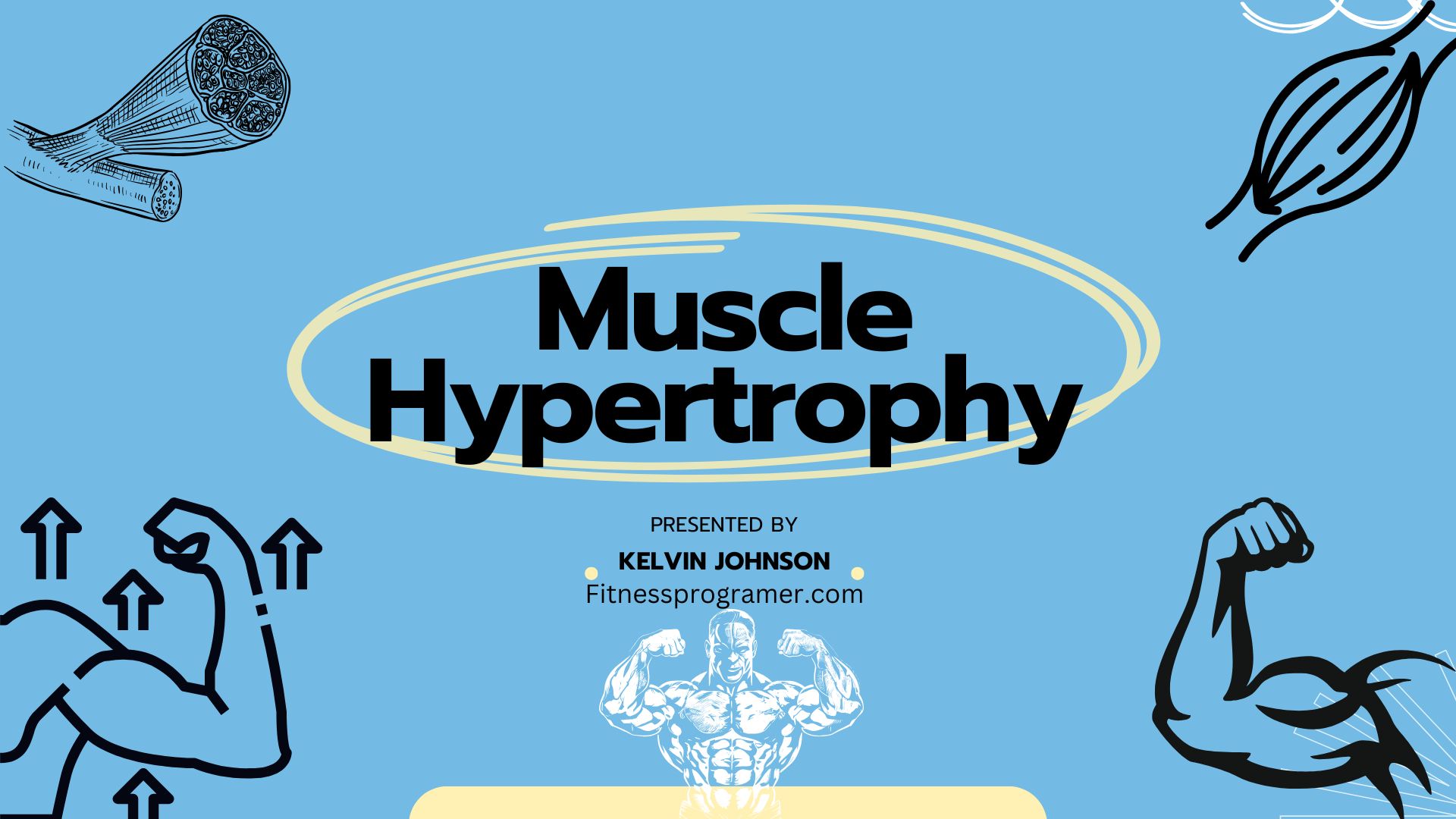Contents
- What Is Muscle Hypertrophy?
- How Does Muscle Hypertrophy Occur?
- Types of Muscle Hypertrophy
- Do Genes Affect Muscle Hypertrophy?
- What Is Myostatin Muscle Hypertrophy?
- What Should Be Done to Increase Muscle Size and Build Muscle?
- How Often Should You Exercise to Achieve Muscle Hypertrophy?
- What Are the Best Ways to Get the Most Out of Your Exercises for Muscle Hypertrophy?
- How Should You Eat to Build Muscle?
- How to Increase Muscle Size? (Quick Checklist)
- What Are the Benefits of Muscle Hypertrophy?
- Conclusion
- References
Hypertrophy is a biological term that refers to the enlargement of an organ or tissue from the increase in the size of its cells. In fitness, muscle hypertrophy specifically describes an increase in muscle fiber size, resulting in visible muscular growth.
It is a primary goal for many athletes, bodybuilders, and fitness enthusiasts aiming to enhance aesthetics, strength, and overall performance.
What Is Muscle Hypertrophy?
Muscle hypertrophy is the adaptive response of muscle tissue to repeated resistance training. As you subject your muscles to mechanical tension, they respond by increasing the cross-sectional area of muscle fibers.
This growth results in:
- Increased strength
- Enhanced metabolic function
- Improved physique
How Does Muscle Hypertrophy Occur?
Muscle hypertrophy is primarily triggered by three key mechanisms (Schoenfeld, 2010):
- Mechanical Tension:
Load-induced force on the muscle during resistance exercise (e.g., squats, push-ups). - Muscle Damage:
Micro-tears from exercise stimulate repair and adaptation (the soreness you feel). - Metabolic Stress:
Accumulated byproducts like lactate during high-rep or high-volume training increase cellular swelling and growth signals.
These mechanisms activate pathways like mTOR (mammalian target of rapamycin), which regulate muscle protein synthesis (MPS)—the building block of hypertrophy.
Types of Muscle Hypertrophy

There are two main types of hypertrophy, each responding to different training stimuli:
1. Myofibrillar Hypertrophy (Functional Hypertrophy)
An increase in the size and number of myofibrils (contractile units of muscle fibers), leading to denser, stronger muscles.
Characteristics:
- Enhances muscular strength and power.
- Minimal increase in muscle size compared to sarcoplasmic hypertrophy.
- Improves force production and neuromuscular efficiency.
Training Style:
- Heavy weights
- Lower reps (3–6)
- Longer rest (2–5 minutes)
- Focus: Compound lifts (e.g., squats, deadlifts, bench press)
2. Sarcoplasmic Hypertrophy (Non-Functional or Size Hypertrophy)
An increase in the volume of sarcoplasmic fluid (non-contractile elements) within the muscle cell, contributing to larger muscle size but not necessarily greater strength.
Characteristics:
- Boosts muscular endurance and muscle size.
- Less improvement in maximal strength.
- Common in bodybuilding training.
Training Style:
- Moderate weights
- Higher reps (6–12+)
- Shorter rest (30–90 seconds)
- Focus: Isolation exercises and volume (multiple sets)
Bonus: Transient Hypertrophy
A temporary increase in muscle size during and immediately after a workout due to increased blood flow (“the pump”).
Characteristics:
- Short-lived swelling of muscles.
- Not related to long-term gains in size or strength.
- Can enhance mind-muscle connection and nutrient delivery.
Summary Table:
| Type | Primary Adaptation | Strength Gain | Size Gain | Training Focus |
|---|---|---|---|---|
| Myofibrillar Hypertrophy | Contractile proteins | High | Moderate | Low reps, heavy loads |
| Sarcoplasmic Hypertrophy | Cell fluid/energy storage | Low | High | High reps, moderate loads |
| Transient Hypertrophy | Blood flow/inflammation | None | Temporary | Pump training |
Do Genes Affect Muscle Hypertrophy?
Yes. Genetics play a significant role in how effectively someone can gain muscle mass. Here’s how:
- Muscle fiber type: Fast-twitch fibers (Type II) hypertrophy more easily than slow-twitch
- Hormonal profile: Higher levels of testosterone and growth hormone favor growth
- Satellite cells: Influence muscle repair and growth
- Myostatin levels: A genetic regulator that inhibits muscle growth (more on this below)
That said, almost everyone can build muscle, even if at different rates.
What Is Myostatin Muscle Hypertrophy?
Myostatin is a protein that limits muscle growth. Individuals with myostatin gene mutations (either natural or through suppression) can experience dramatic hypertrophy, often referred to as “myostatin-related muscle hypertrophy.”
This condition is rare and may cause people to have twice the normal muscle mass—even without extensive training. However, for most people, myostatin remains an important regulator, and training/nutrition must be optimized to build muscle naturally.
What Should Be Done to Increase Muscle Size and Build Muscle?
To promote muscle hypertrophy, you need a consistent and science-backed strategy that includes:
- Resistance training: Use compound and isolation exercises
- Progressive overload: Gradually increase weight, reps, or sets
- Training to near failure: Aim for 1–2 reps short of muscular failure
- Adequate volume: 10–20 sets per muscle group per week
- Sufficient recovery: At least 48 hours between training the same muscle group
- Muscle-focused technique: Prioritize tension and form over heavy weights
Usually, bodybuilding workouts aim to focus on hypertrophy using these strategies.
How Often Should You Exercise to Achieve Muscle Hypertrophy?
Optimal frequency for hypertrophy depends on training volume and individual recovery:
- Beginners: 3 days/week full-body sessions
- Intermediates/Advanced: 4–6 days/week, split routines (e.g., push/pull/legs)
- Ideal frequency: Train each muscle group 2 times per week
This approach maximizes muscle protein synthesis, which lasts about 24–72 hours after training.
What Are the Best Ways to Get the Most Out of Your Exercises for Muscle Hypertrophy?
- Use compound lifts (squat, deadlift, bench press) for total mass
- Add isolation exercises for weak points (e.g., biceps, delts)
- Focus on form and full range of motion
- Incorporate tempo training (slow eccentrics)
- Keep rest periods between 30–90 seconds for hypertrophy
- Use drop sets, supersets, and pyramids to increase metabolic stress
- Track your progress weekly to ensure progressive overload
How Should You Eat to Build Muscle?
Nutrition is half the battle in hypertrophy. Follow these principles:
Macronutrients:
- Calories: Surplus of ~250–500 kcal/day
- Protein: 1.6–2.2g per kg of body weight per day
- Carbs: Fuel for training and recovery (3–5g/kg)
- Fats: Essential for hormone production (0.8–1g/kg)
Timing:
- Eat 20–40g of protein every 3–4 hours
- Consume carbs + protein post-workout to support MPS
- Stay hydrated to support recovery and cellular volume
How to Increase Muscle Size? (Quick Checklist)
✔ Train consistently with resistance exercises
✔ Use progressive overload strategies
✔ Hit each muscle 2x/week
✔ Eat in a calorie surplus with enough protein
✔ Sleep 7–9 hours/night for recovery
✔ Manage stress and track results
What Are the Benefits of Muscle Hypertrophy?
- Improved strength and performance
- Higher resting metabolic rate (burn more calories at rest)
- Better bone density and joint support
- Boosted mood and cognitive function
- Reduced risk of chronic diseases (diabetes, heart disease)
- Enhanced appearance, confidence, and posture
Conclusion
Muscle hypertrophy isn’t just for bodybuilders—it’s a fundamental adaptation that benefits nearly everyone. Whether you’re training for health, aesthetics, or performance, understanding how muscle grows, what influences it, and how to apply the principles of hypertrophy will empower you to reach your goals effectively.
Commit to the process, follow the science, and the gains will come.
References
- Schoenfeld, B. J. (2010). The mechanisms of muscle hypertrophy and their application to resistance training. Journal of Strength and Conditioning Research, 24(10), 2857–2872. Read the study
- Haun, C. T., et al. (2019). Training volume and muscle hypertrophy: a systematic review. Frontiers in Physiology, 10, 447. Read the study
- McCall, G. E., et al. (1999). Muscle fiber hypertrophy, hyperplasia, and capillary density in college men after resistance training. Journal of Applied Physiology, 81(5), 2004–2012. Read the study



